Spatio-Temporal Modeling of Land and Pasture Vulnerability in Dairy Basins in Northeastern Brazil
Abstract
:1. Introduction
2. Materials and Methods
2.1. Study Area
2.2. Dynamics of Vegetation Cover via MapBiomas Brasil
2.3. Orbital Satellite Data: Landsat 5—Thematic Mapper (TM) and Landsat 8—Operational Land Imager (OLI)
2.4. Determining and Classifying Land Slope
2.5. Land Vulnerability Index (LVI)
2.6. Characterization of the Cattle Herd, Milked Cows and Milk Production Time Series by Municipality
2.7. Pasture Cover Dynamics via the Pasture Atlas
2.8. Pasture Quality via MapBiomas Pasture
2.9. Statistical Procedures
3. Results and Discussion
3.1. Land Use and Cover Classes via MapBiomas Brasil
3.2. Analysis of Slope and Index of Vulnerability to Degradation (IVD)
3.3. Evaluation Land Vulnerability Index (LVI)
3.4. Time Series Analysis of the Herd, Milked Cows and Milk Production
3.5. Analysis of the Dynamics of Pasture Cover and Quality
3.6. Statistical Analysis
4. Conclusions
Author Contributions
Funding
Data Availability Statement
Acknowledgments
Conflicts of Interest
References
- IPCC. The Intergovernmental Panel on Climate Change. Available online: https://www.ipcc.ch/ (accessed on 31 August 2023).
- Huang, J.; Ji, M.; Xie, Y.; Wang, S.; He, Y.; Ran, J. Global Semi-Arid Climate Change over Last 60 Years. Clim. Dyn. 2016, 46, 1131–1150. [Google Scholar] [CrossRef]
- Stavi, I.; Pinho, J.R.; Paschalidou, A.K.; Adamo, S.B.; Galvin, K.; Sherbinin, A.; Even, T.; Heaviside, C.; van der Geest, K. Food Security among Dryland Pastoralists and Agropastoralists: The Climate, Land-Use Change, and Population Dynamics Nexus. Anthr. Rev. 2022, 9, 299–323. [Google Scholar] [CrossRef]
- Burney, J.; Cesano, D.; Russell, J.; La Rovere, E.L.; Corral, T.; Coelho, N.S.; Santos, L. Climate Change Adaptation Strategies for Smallholder Farmers in the Brazilian Sertão. Clim. Chang. 2014, 126, 45–59. [Google Scholar] [CrossRef]
- Oliveira, M.L.; Santos, C.A.C.; Oliveira, G.; Perez-Marin, A.M.; Santos, C.A.G. Effects of Human-Induced Land Degradation on Water and Carbon Fluxes in Two Different Brazilian Dryland Soil Covers. Sci. Total Environ. 2021, 792, 148458. [Google Scholar] [CrossRef] [PubMed]
- Andrade, C.W.L.; Montenegro, S.M.G.L.; Montenegro, A.A.A.; Lima, J.R.S.; Srinivasan, R.; Jones, C.A. Climate Change Impact Assessment on Water Resources under RCP Scenarios: A Case Study in Mundaú River Basin, Northeastern Brazil. Int. J. Climatol. 2021, 41, E1045–E1061. [Google Scholar] [CrossRef]
- Maranhão, S.R.; Silva, R.G.; Araújo, G.G.L.; Cândido, M.J.D. Modeling the Water Balance of a Ruminant Production System in the Semi-Arid Region. Afr. J. Agric. Res. 2022, 18, 127–135. [Google Scholar] [CrossRef]
- Medeiros, S.S. Estabelecimentos Agropecuários do Semiárido Brasileiro, 1st ed.; Instituto Nacional do Semiárido: Campina Grande, Brazil, 2018. [Google Scholar]
- Silva, J.L.B.; Moura, G.B.A.; Silva, M.V.; Lopes, P.M.O.; Guedes, R.V.S.; Silva, Ê.F.F.; Ortiz, P.F.S.; Rodrigues, J.A.M. Changes in the Water Resources, Soil Use and Spatial Dynamics of Caatinga Vegetation Cover over Semiarid Region of the Brazilian Northeast. Remote Sens. Appl. 2020, 20, 100372. [Google Scholar] [CrossRef]
- Vieira, R.M.D.S.P.; Tomasella, J.; Barbosa, A.A.; Martins, M.A.; Rodriguez, D.A.; Rezende, F.S.D.; Carriello, F.; Santana, M.D.O. Desertification Risk Assessment in Northeast Brazil: Current Trends and Future Scenarios. Land Degrad. Dev. 2021, 32, 224–240. [Google Scholar] [CrossRef]
- Queiroz, M.G.; Silva, T.G.F.; Zolnier, S.; Jardim, A.M.R.F.; Souza, C.A.A.; Araújo Júnior, G.N.; Morais, J.E.F.; Souza, L.S.B. Spatial and Temporal Dynamics of Soil Moisture for Surfaces with a Change in Land Use in the Semi-Arid Region of Brazil. Catena 2020, 188, 104457. [Google Scholar] [CrossRef]
- Althoff, T.D.; Menezes, R.S.C.; Pinto, A.S.; Pareyn, F.G.C.; Carvalho, A.L.; Martins, J.C.R.; Carvalho, E.X.; Silva, A.S.A.; Dutra, E.D.; Sampaio, E.V.S.B. Adaptation of the Century Model to Simulate C and N Dynamics of Caatinga Dry Forest before and after Deforestation. Agric. Ecosyst. Environ. 2018, 254, 26–34. [Google Scholar] [CrossRef]
- Fernandes, M.M.; Fernandes, M.R.M.; Garcia, J.R.; Matricardi, E.A.T.; Lima, A.H.S.; Filho, R.N.A.; Filho, R.R.G.; Piscoya, V.C.; Piscoya, T.O.F.; Filho, M.C. Land Use and Land Cover Changes and Carbon Stock Valuation in the São Francisco River Basin, Brazil. Environ. Chall. 2021, 5, 100247. [Google Scholar] [CrossRef]
- Medeiros, A.S.; Maia, S.M.F.; Santos, T.C.; Gomes, T.C.A. Soil Carbon Losses in Conventional Farming Systems Due to Land-Use Change in the Brazilian Semi-Arid Region. Agric. Ecosyst. Environ. 2020, 287, 106690. [Google Scholar] [CrossRef]
- Campos, S.A.C.; Ferreira, M.D.P.; Coelho, A.B.; Lima, J.E. Degradação Ambiental Agropecuária No Bioma Caatinga. Rev. Econ. Nordeste 2016, 46, 155–170. [Google Scholar] [CrossRef]
- Naorem, A.; Jayaraman, S.; Dang, Y.P.; Dalal, R.C.; Sinha, N.K.; Rao, C.S.; Patra, A.K. Soil Constraints in an Arid Environment—Challenges, Prospects, and Implications. Agronomy 2023, 13, 220. [Google Scholar] [CrossRef]
- Balmford, A.; Amano, T.; Bartlett, H.; Chadwick, D.; Collins, A.; Edwards, D.; Field, R.; Garnsworthy, P.; Green, R.; Smith, P.; et al. The Environmental Costs and Benefits of High-Yield Farming. Nat. Sustain. 2018, 1, 477–485. [Google Scholar] [CrossRef]
- Britt, J.H.; Cushman, R.A.; Dechow, C.D.; Dobson, H.; Humblot, P.; Hutjens, M.F.; Jones, G.A.; Mitloehner, F.M.; Ruegg, P.L.; Sheldon, I.M.; et al. Review: Perspective on High-Performing Dairy Cows and Herds. Animal 2021, 15, 100298. [Google Scholar] [CrossRef] [PubMed]
- von Keyserlingk, M.A.G.; Martin, N.P.; Kebreab, E.; Knowlton, K.F.; Grant, R.J.; Stephenson, M.; Sniffen, C.J.; Harner, J.P.; Wright, A.D.; Smith, S.I. Invited Review: Sustainability of the US Dairy Industry. J. Dairy Sci. 2013, 96, 5405–5425. [Google Scholar] [CrossRef]
- Neethirajan, S. Innovative Strategies for Sustainable Dairy Farming in Canada amidst Climate Change. Sustainability 2023, 16, 265. [Google Scholar] [CrossRef]
- Dias Filho, M.B. Diagnóstico Das Pastagens No Brasil; Embrapa Amazônia Oriental, Ed.; Embrapa Amazônia Oriental: Belém, Brazil, 2014; Volume 1. [Google Scholar]
- Silva, M.V.; Pandorfi, H.; Almeida, G.L.P.; Lima, R.P.; Santos, A.; Jardim, A.M.R.F.; Rolim, M.M.; Silva, J.L.B.; Batista, P.H.D.; Silva, R.A.B.; et al. Spatio-Temporal Monitoring of Soil and Plant Indicators under Forage Cactus Cultivation by Geoprocessing in Brazilian Semi-Arid Region. J. S. Am. Earth Sci. 2021, 107, 103155. [Google Scholar] [CrossRef]
- IBGE. Censo Agro. 2017. Available online: https://censos.ibge.gov.br/agro/2017/templates/censo_agro/resultadosagro/pecuaria.html?localidade=0&tema=75657 (accessed on 21 August 2023).
- Batista, P.H.D.; Almeida, G.L.P.; Silva, J.L.B.; Pandorfi, H.; Silva, M.V.; Silva, R.A.B.; Melo, M.V.N.; Lins, F.A.C.; Cordeiro, J.J.F., Jr. Short-Term Grazing and Its Impacts on Soil and Pasture Degradation. Dyna 2020, 87, 123–128. [Google Scholar] [CrossRef]
- Bolfe, É.L.; Victoria, D.C.; Sano, E.E.; Bayma, G.; Massruhá, S.M.F.S.; Oliveira, A.F. Potential for Agricultural Expansion in Degraded Pasture Lands in Brazil Based on Geospatial Databases. Land 2024, 13, 200. [Google Scholar] [CrossRef]
- Andrade, T.S.; Cunha, J.E.B.L.; Galvão, C.O.; Rufino, I.A.A. Milk Production as an Indicator of Drought Vulnerability of Cities Located in the Brazilian Semiarid Region. Eng. Agrícola 2017, 37, 1203–1212. [Google Scholar] [CrossRef]
- Feltran-Barbieri, R.; Féres, J.G. Degraded Pastures in Brazil: Improving Livestock Production and Forest Restoration. R. Soc. Open Sci. 2021, 8, 201854. [Google Scholar] [CrossRef] [PubMed]
- Muralikrishnan, L.; Padaria, R.N.; Choudhary, A.K.; Dass, A.; Shokralla, S.; El-Abedin, T.K.Z.; Abdelmohsen, S.A.M.; Mahmoud, E.A.; Elansary, H.O. Climate Change-Induced Drought Impacts, Adaptation and Mitigation Measures in Semi-Arid Pastoral and Agricultural Watersheds. Sustainability 2021, 14, 6. [Google Scholar] [CrossRef]
- Weng, C.; Bai, Y.; Chen, B.; Hu, Y.; Shu, J.; Chen, Q.; Wang, P. Assessing the Vulnerability to Climate Change of a Semi-Arid Pastoral Social–Ecological System: A Case Study in Hulunbuir, China. Ecol. Inf. 2023, 76, 102139. [Google Scholar] [CrossRef]
- Ndiritu, S.W. Drought Responses and Adaptation Strategies to Climate Change by Pastoralists in the Semi-Arid Area, Laikipia County, Kenya. Mitig. Adapt. Strat. Glob. Chang. 2021, 26, 10. [Google Scholar] [CrossRef]
- Fust, P.; Schlecht, E. Importance of Timing: Vulnerability of Semi-Arid Rangeland Systems to Increased Variability in Temporal Distribution of Rainfall Events as Predicted by Future Climate Change. Ecol. Model. 2022, 468, 109961. [Google Scholar] [CrossRef]
- Nandintsetseg, B.; Boldgiv, B.; Chang, J.; Ciais, P.; Davaanyam, E.; Batbold, A.; Bat-Oyun, T.; Stenseth, N.C. Risk and Vulnerability of Mongolian Grasslands under Climate Change. Environ. Res. Lett. 2021, 16, 034035. [Google Scholar] [CrossRef]
- Pereira, P.; Bogunovic, I. Land Degradation Neutrality. How to Reverse Land Degradation with Conservation Agriculture Practices. In Proceedings of the 12th International Scientific/Professional Conference Agriculture in Nature and Environment Protection, Osijek, Croatia, 7–9 September 2019; pp. 27–29. [Google Scholar]
- Gibbs, H.K.; Salmon, J.M. Mapping the World’s Degraded Lands. Appl. Geogr. 2015, 57, 12–21. [Google Scholar] [CrossRef]
- Zhou, N.; Hu, X.; Byskov, I.; Næss, J.S.; Wu, Q.; Zhao, W.; Cherubini, F. Overview of Recent Land Cover Changes, Forest Harvest Areas, and Soil Erosion Trends in Nordic Countries. Geogr. Sustain. 2021, 2, 163–174. [Google Scholar] [CrossRef]
- MAPBIOMAS BRASIL. Plataforma de Mapas e Dados. Available online: http://plataforma.mapbiomas.org/map (accessed on 20 October 2023).
- Alvares, C.A.; Stape, J.L.; Sentelhas, P.C.; Gonçalves, J.L.M.; Sparovek, G. Köppen’s Climate Classification Map for Brazil. Meteorol. Z. 2013, 22, 711–728. [Google Scholar] [CrossRef]
- Beck, H.E.; Zimmermann, N.E.; McVicar, T.R.; Vergopolan, N.; Berg, A.; Wood, E.F. Present and Future Köppen-Geiger Climate Classification Maps at 1-Km Resolution. Sci. Data 2018, 5, 180214. [Google Scholar] [CrossRef]
- INMET. Dados Históricos Anuais. Available online: https://portal.inmet.gov.br/dadoshistoricos (accessed on 25 August 2023).
- INMET. Normais Climatológicas Do Brasil. Available online: https://portal.inmet.gov.br/normais (accessed on 26 August 2023).
- FAO. OECD-FAO Agricultural Outlook 2020–2029, 1st ed.; Paris/FAO, Ed.; OECD: Rome, Italy, 2020; Volume 1, ISBN 9789264317673. [Google Scholar]
- Agrofy News Quem São Os Maiores Produtores de Leite Do Mundo? | Agrofy News. Available online: https://news.agrofy.com.br/noticia/201002/quem-sao-os-maiores-produtores-leite-do-mundo (accessed on 28 July 2024).
- Embrapa Lei Baixo Carbono; Embrapa Brazilian Agricultural Research Corporation: Brasília, Brazil, 2023.
- IBGE. Panorama Brasil. Available online: https://cidades.ibge.gov.br/brasil/panorama (accessed on 21 August 2023).
- Wu, Z.; Du, Y.; Yang, G.; Lin, L.; Hou, X.; Tan, Y.; Fan, X.; Ren, Y.; Wu, B.; Liu, S.; et al. Improving the Sustainability of Milk Production across Different Climate Regions in China. Sustain. Prod. Consum. 2024, 49, 446–461. [Google Scholar] [CrossRef]
- Bórawski, P.; Pawlewicz, A.; Parzonko, A.; Harper, J.K.; Holden, L. Factors Shaping Cow’s Milk Production in the EU. Sustainability 2020, 12, 420. [Google Scholar] [CrossRef]
- Barreto, J.B.; Silva, J.B.; Araújo, S.M.S.; Teixeira, R.O. Análise Do Sistema de Validação e Refinamento de Alertas Do Mapbiomas e Do Laudo de Área Desmatada Em Altamira—PA, Brasil (2018–2021). Res. Soc. Dev. 2021, 10, e37810615801. [Google Scholar] [CrossRef]
- Marengo, J.A.; Alves, L.M.; Alvala, R.C.S.; Cunha, A.P.; Brito, S.; Moraes, O.L.L. Climatic Characteristics of the 2010-2016 Drought in the Semiarid Northeast Brazil Region. Acad. Bras. Cienc. 2018, 90, 1973–1985. [Google Scholar] [CrossRef]
- Santos, A.; Lopes, P.M.O.; Silva, M.V.; Jardim, A.M.R.F.; Moura, G.B.A.; Fernandes, G.S.T.; Silva, D.A.O.; Silva, J.L.B.; Rodrigues, J.A.M.; Silva, E.A.; et al. Causes and Consequences of Seasonal Changes in the Water Flow of the São Francisco River in the Semiarid of Brazil. Environ. Sustain. Indic. 2020, 8, 100084. [Google Scholar] [CrossRef]
- NASA. Landsat Science. Available online: https://landsat.gsfc.nasa.gov/ (accessed on 28 July 2024).
- Kumar, B.P.; Babu, K.R.; Anusha, B.N.; Rajasekhar, M. Geo-Environmental Monitoring and Assessment of Land Degradation and Desertification in the Semi-Arid Regions Using Landsat 8 OLI/TIRS, LST, and NDVI Approach. Environ. Chall. 2022, 8, 100578. [Google Scholar] [CrossRef]
- Hu, Y.; Raza, A.; Syed, N.R.; Acharki, S.; Ray, R.L.; Hussain, S.; Dehghanisanij, H.; Zubair, M.; Elbeltagi, A. Land Use/Land Cover Change Detection and NDVI Estimation in Pakistan’s Southern Punjab Province. Sustainability 2023, 15, 3572. [Google Scholar] [CrossRef]
- Yasin, M.Y.; Abdullah, J.; Noor, N.M.; Yusoff, M.M.; Noor, N.M. Landsat Observation of Urban Growth and Land Use Change Using NDVI and NDBI Analysis. IOP Conf. Ser. Earth Environ. Sci. 2022, 1067, 012037. [Google Scholar] [CrossRef]
- USGS/NASA. Landsat Satellite Missions. Available online: https://www.usgs.gov/landsat-missions/landsat-satellite-missions (accessed on 13 December 2022).
- Silva, J.L.B.; Refati, D.C.; Lima, R.C.C.; Carvalho, A.A.; Ferreira, M.B.; Pandorfi, H.; Silva, M.V. Techniques of Geoprocessing via Cloud in Google Earth Engine Applied to Vegetation Cover and Land Use and Occupation in the Brazilian Semiarid Region. Geographies 2022, 2, 593–608. [Google Scholar] [CrossRef]
- von Keyserlingk, J.; Thieken, A.; Paton, E. Approaches to Assess Land Degradation Risk: A Synthesis. Ecol. Soc. 2023, 28, art53. [Google Scholar] [CrossRef]
- Lopes, I.C.P.; Campos, J.A. Capacidade de Uso Da Terra Da Sub-Bacia Do Córrego Maria Comprida Usando Sistemas de Informações Geográficas. J. Environ. Anal. Prog. 2019, 4, 110–121. [Google Scholar] [CrossRef]
- Embrapa. Sistema Brasileiro de Classificação de Solos, 2nd ed.; Embrapa Solos, Ed.; Embrapa: Rio de Janeiro, Brazil, 2006; ISBN 8585864192. [Google Scholar]
- Rouse, J.W.; Haas, R.H.; Schell, J.A.; Deering, D.W. Monitoring Vegetation Systems in the Great Plains with ERTS. In Earth Resources Technology Satellite-1 Symposium; NASA: Washington, DC, USA, 1973; Volume 1, pp. 309–317. [Google Scholar]
- Allen, R.G.; Tasumi, M.; Trezza, R.; Waters, R.; Bastiaanssen, W. SEBAL (Surface Energy Balance Algorithms for Land). In Advanced Training and Users Manual; Idaho Implementation; University of Idaho: Moscow, ID, USA, 2002; Volume 1, 97p. [Google Scholar]
- Chaves, I.B.; Lopes, V.L.; Folliott, P.F.; Paes-Silva, A.P. Uma Classificação Morfo-Estrutural Para Descrição e Avaliação Da Biomassa Da Vegetação Da Caatinga. Rev. Caatinga 2008, 21, 204–213. [Google Scholar]
- Weishaupt, A.; Ekardt, F.; Garske, B.; Stubenrauch, J.; Wieding, J. Land Use, Livestock, Quantity Governance, and Economic Instruments—Sustainability Beyond Big Livestock Herds and Fossil Fuels. Sustainability 2020, 12, 2053. [Google Scholar] [CrossRef]
- Hennessy, D.; Delaby, L.; van den Pol-van Dasselaar, A.; Shalloo, L. Increasing Grazing in Dairy Cow Milk Production Systems in Europe. Sustainability 2020, 12, 2443. [Google Scholar] [CrossRef]
- Wilkinson, J.M.; Lee, M.R.F.; Rivero, M.J.; Chamberlain, A.T. Some Challenges and Opportunities for Grazing Dairy Cows on Temperate Pastures. Grass Forage Sci. 2020, 75, 1–17. [Google Scholar] [CrossRef]
- LAPIG/UFG. Áreas de Pastagem. Available online: https://atlasdaspastagens.ufg.br/assets/hotsite/documents/metodos/pt/%C3%81rea%20de%20Pastagem.pdf (accessed on 4 September 2023).
- MAPBIOMAS BRASIL Pastagens Brasileiras Ocupam Área Equivalente a Todo o Estado Do Amazonas. Available online: https://mapbiomas.org/pastagens-brasileiras-ocupam-area-equivalente-a-todo-o-estado-do-amazonas (accessed on 27 October 2023).
- Kaiser, H.F. The Varimax Criterion for Analytic Rotation in Factor Analysis. Psychometrika 1958, 23, 187–200. [Google Scholar] [CrossRef]
- Silva, M.V.; Pandorfi, H.; Oliveira-Júnior, J.F.; Silva, J.L.B.; Almeida, G.L.P.; Montenegro, A.A.A.; Mesquita, M.; Ferreira, M.B.; Santana, T.C.; Marinho, G.T.B.; et al. Remote Sensing Techniques via Google Earth Engine for Land Degradation Assessment in the Brazilian Semiarid Region, Brazil. J. S. Am. Earth Sci. 2022, 120, 104061. [Google Scholar] [CrossRef]
- R Core Team. R: A Language and Environment for Statistical Computing. Available online: https://www.r-project.org/ (accessed on 6 February 2023).
- Barreto-Garcia, P.A.B.; Batista, S.G.M.; Gama-Rodrigues, E.F.; Paula, A.; Batista, W.C.A. Short-Term Effects of Forest Management on Soil Microbial Biomass and Activity in Caatinga Dry Forest, Brazil. Ecol. Manag. 2021, 481, 118790. [Google Scholar] [CrossRef]
- Fernandes, M.M.; Fernandes, M.R.M.; Garcia, J.R.; Matricardi, E.A.T.; Almeida, A.Q.; Pinto, A.S.; Menezes, R.S.C.; Silva, A.J.; Lima, A.H.S. Assessment of Land Use and Land Cover Changes and Valuation of Carbon Stocks in the Sergipe Semiarid Region, Brazil: 1992–2030. Land Use Policy 2020, 99, 104795. [Google Scholar] [CrossRef]
- Melo, M.V.N.; Oliveira, M.E.G.; Almeida, G.L.P.; Gomes, N.F.; Morales, K.R.M.; Santana, T.C.; Silva, P.C.; Moraes, A.S.; Pandorfi, H.; Silva, M.V. Spatiotemporal Characterization of Land Cover and Degradation in the Agreste Region of Pernambuco, Brazil, Using Cloud Geoprocessing on Google Earth Engine. Remote Sens. Appl. 2022, 26, 100756. [Google Scholar] [CrossRef]
- MAPBIOMAS BRASIL. Análise de Acurácia. Available online: https://mapbiomas.org/analise-de-acuracia (accessed on 5 November 2023).
- Sousa Júnior, V.P.; Sparacino, J.; Espindola, G.M.; Sousa de Assis, R.J. Land-Use and Land-Cover Dynamics in the Brazilian Caatinga Dry Tropical Forest. Conservation 2022, 2, 739–752. [Google Scholar] [CrossRef]
- So, H.B.; Khalifa, A.M.; Yu, B.; Caroll, C.; Burger, P.; Mulligan, D. MINErosion 3: Using Measurements on a Tilting Flume-Rainfall Simulator Facility to Predict Erosion Rates from Post-Mining Landscapes in Central Queensland, Australia. PLoS ONE 2018, 13, e0194230. [Google Scholar] [CrossRef]
- Brasil Lei No 12.727, de 17 de Outubro de 2012. Available online: https://www.planalto.gov.br/ccivil_03/_ato2011-2014/2012/lei/l12727.htm (accessed on 19 June 2023).
- Tolche, A.D.; Gurara, M.A.; Pham, Q.B.; Anh, D.T. Modelling and Accessing Land Degradation Vulnerability Using Remote Sensing Techniques and the Analytical Hierarchy Process Approach. Geocarto Int. 2022, 37, 7122–7142. [Google Scholar] [CrossRef]
- Hossain, A.; Krupnik, T.J.; Timsina, J.; Mahboob, M.G.; Chaki, A.K.; Farooq, M.; Bhatt, R.; Fahad, S.; Hasanuzzaman, M. Agricultural Land Degradation: Processes and Problems Undermining Future Food Security. In Environment, Climate, Plant and Vegetation Growth; Springer International Publishing: Cham, Switzerland, 2020; pp. 17–61. [Google Scholar]
- Duguma, B.; Janssens, G.P.J. Assessment of Livestock Feed Resources and Coping Strategies with Dry Season Feed Scarcity in Mixed Crop–Livestock Farming Systems around the Gilgel Gibe Catchment, Southwest Ethiopia. Sustainability 2021, 13, 10713. [Google Scholar] [CrossRef]
- Cantalice, J.R.B.; Nunes, E.O.S.; Cavalcante, D.M.; Barbosa, B.; Barros Junior, G.; Guerra, S.M.S.; Rolim Neto, F.C. Vegetative-Hydraulic Parameters Generated by Agricultural Crops for Laminar Flows under a Semi-Arid Environment of Pernambuco, Brazil. Ecol. Indic. 2019, 106, 105496. [Google Scholar] [CrossRef]
- Almeida, R.F. Palma Forrageira na Alimentação de Ovinos e Caprinos No Semi-Árido Brasileiro. Rev. Verde Agroecol. Desenvolv. Sustentável 2012, 7, 08–14. [Google Scholar]
- Silva, J.B.A.; Almeida, G.L.P.; Silva, M.V.; Oliveira-Junior, J.F.; Pandorfi, H.; Sousa, A.M.O.; Marinho, G.T.B.; Giongo, P.R.; Ferreira, M.B.; Sousa, J.S.; et al. Characterization of Water Status and Vegetation Cover Change in a Watershed in Northeastern Brazil. J. S. Am. Earth Sci. 2023, 130, 104546. [Google Scholar] [CrossRef]
- Silva, J.L.B.; Moura, G.B.A.; Silva, M.V.; Oliveira-Júnior, J.F.; Jardim, A.M.R.F.; Refati, D.C.; Lima, R.C.C.; Carvalho, A.A.; Ferreira, M.B.; Brito, J.I.B.; et al. Environmental Degradation of Vegetation Cover and Water Bodies in the Semiarid Region of the Brazilian Northeast via Cloud Geoprocessing Techniques Applied to Orbital Data. J. S. Am. Earth Sci. 2023, 121, 104164. [Google Scholar] [CrossRef]
- Montcho, M.; Padonou, E.A.; Montcho, M.; Mutua, M.N.; Sinsin, B. Perception and Adaptation Strategies of Dairy Farmers towards Climate Variability and Change in West Africa. Clim. Chang. 2022, 170, 38. [Google Scholar] [CrossRef]
- Seidou, A.A.; Offoumon, O.T.L.F.; Worogo, S.H.S.; Houaga, I.; Yarou, A.K.; Azalou, M.; Boukari, F.Z.A.; Idrissou, Y.; Houinato, M.; Traoré, I.A. The Effect of the Silvopastoral System on Milk Production and Reproductive Performance of Dairy Cows and Its Contribution to Adaptation to a Changing Climate in the Drylands of Benin (West-Africa). Front. Sustain. Food Syst. 2023, 7, 1236581. [Google Scholar] [CrossRef]
- Oleggini, G.H.; Ely, L.O.; Smith, J.W. Effect of Region and Herd Size on Dairy Herd Performance Parameters. J. Dairy Sci. 2001, 84, 1044–1050. [Google Scholar] [CrossRef]
- Silva, C.M.; Costa Júnior, C.E.O. 228Ra in Cow’s Milk from an Anomalous Region of Pernambuco-Brazil. Int. J. Environ. Stud. 2019, 76, 357–369. [Google Scholar] [CrossRef]
- Oumou, S.H.; Samuel, N.B.; Salif, K.; Valérie, B.M.C. Analysis of Dairy Farming Systems in the Sahelian Zone of Burkina Faso. Trop. Anim. Health Prod. 2022, 54, 92. [Google Scholar] [CrossRef] [PubMed]
- Wankar, A.K.; Rindhe, S.N.; Doijad, N.S. Heat Stress in Dairy Animals and Current Milk Production Trends, Economics, and Future Perspectives: The Global Scenario. Trop. Anim. Health Prod. 2021, 53, 70. [Google Scholar] [CrossRef]
- Brizga, J.; Kurppa, S.; Heusala, H. Environmental Impacts of Milking Cows in Latvia. Sustainability 2021, 13, 784. [Google Scholar] [CrossRef]
- Froldi, F.; Lamastra, L.; Trevisan, M.; Mambretti, D.; Moschini, M. Environmental Impacts of Cow’s Milk in Northern Italy: Effects of Farming Performance. J. Clean. Prod. 2022, 363, 132600. [Google Scholar] [CrossRef]
- Darré, E.; Llanos, E.; Astigarraga, L.; Cadenazzi, M.; Picasso, V. Do Pasture-Based Mixed Dairy Systems with Higher Milk Production Have Lower Environmental Impacts? A Uruguayan Case Study. New Zealand J. Agric. Res. 2021, 64, 444–462. [Google Scholar] [CrossRef]
- Wilkinson, J.M.; Chamberlain, A.T.; Rivero, M.J. The Case for Grazing Dairy Cows. Agronomy 2021, 11, 2466. [Google Scholar] [CrossRef]
- Castro, C.N. Aspectos Socieconômicos da Região do Matopiba; Instituto de Pesquisa Econômica Aplicada (IPEA): Brasília, Brazil, 2018.
- Godde, C.M.; Boone, R.B.; Ash, A.J.; Waha, K.; Sloat, L.L.; Thornton, P.K.; Herrero, M. Global Rangeland Production Systems and Livelihoods at Threat under Climate Change and Variability. Environ. Res. Lett. 2020, 15, 044021. [Google Scholar] [CrossRef]
- Wróbel, B.; Zielewicz, W.; Staniak, M. Challenges of Pasture Feeding Systems—Opportunities and Constraints. Agriculture 2023, 13, 974. [Google Scholar] [CrossRef]
- Hu, W.; Drewry, J.; Beare, M.; Eger, A.; Müller, K. Compaction Induced Soil Structural Degradation Affects Productivity and Environmental Outcomes: A Review and New Zealand Case Study. Geoderma 2021, 395, 115035. [Google Scholar] [CrossRef]
- FAO. The State of Food and Agriculture, 1st ed.; FAO: Rome, Italy, 2009; Volume 1. [Google Scholar]
- Gosch, M.S.; Parente, L.L.; Santos, C.O.; Mesquita, V.V.; Ferreira, L.G. Landsat-Based Assessment of the Quantitative and Qualitative Dynamics of the Pasture Areas in Rural Settlements in the Cerrado Biome, Brazil. Appl. Geogr. 2021, 136, 102585. [Google Scholar] [CrossRef]
- Duguma, B. Farmers’ Perceptions of Major Challenges to Smallholder Dairy Farming in Selected Towns of Jimma Zone, Oromia Regional State, Ethiopia: Possible Influences, Impacts, Coping Strategies and Support Required. Heliyon 2022, 8, e09581. [Google Scholar] [CrossRef]
- Salvati, L.; Mavrakis, A.; Colantoni, A.; Mancino, G.; Ferrara, A. Complex Adaptive Systems, Soil Degradation and Land Sensitivity to Desertification: A Multivariate Assessment of Italian Agro-Forest Landscape. Sci. Total Environ. 2015, 521–522, 235–245. [Google Scholar] [CrossRef] [PubMed]
- Zeraatpisheh, M.; Ayoubi, S.; Sulieman, M.; Rodrigo-Comino, J. Determining the Spatial Distribution of Soil Properties Using the Environmental Covariates and Multivariate Statistical Analysis: A Case Study in Semi-Arid Regions of Iran. J. Arid. Land 2019, 11, 551–566. [Google Scholar] [CrossRef]
- Silva, M.V.; Pandorfi, H.; Lopes, P.M.O.; Silva, J.L.B.; Almeida, G.L.P.; Silva, D.A.O.; Santos, A.; Rodrigues, J.A.M.; Batista, P.H.D.; Jardim, A.M.R.F. Pilot Monitoring of Caatinga Spatial-Temporal Dynamics through the Action of Agriculture and Livestock in the Brazilian Semiarid. Remote Sens. Appl. 2020, 19, 100353. [Google Scholar] [CrossRef]
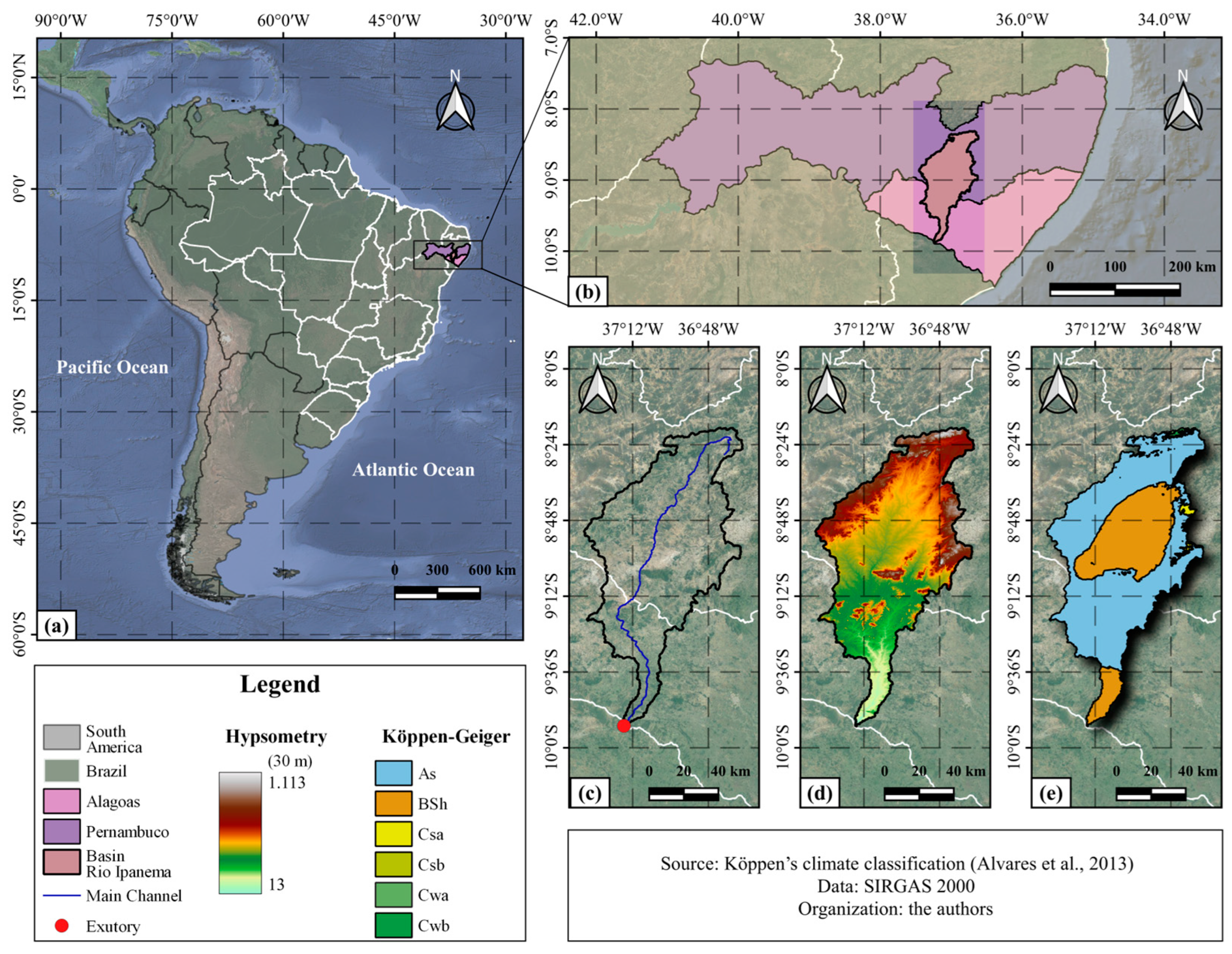
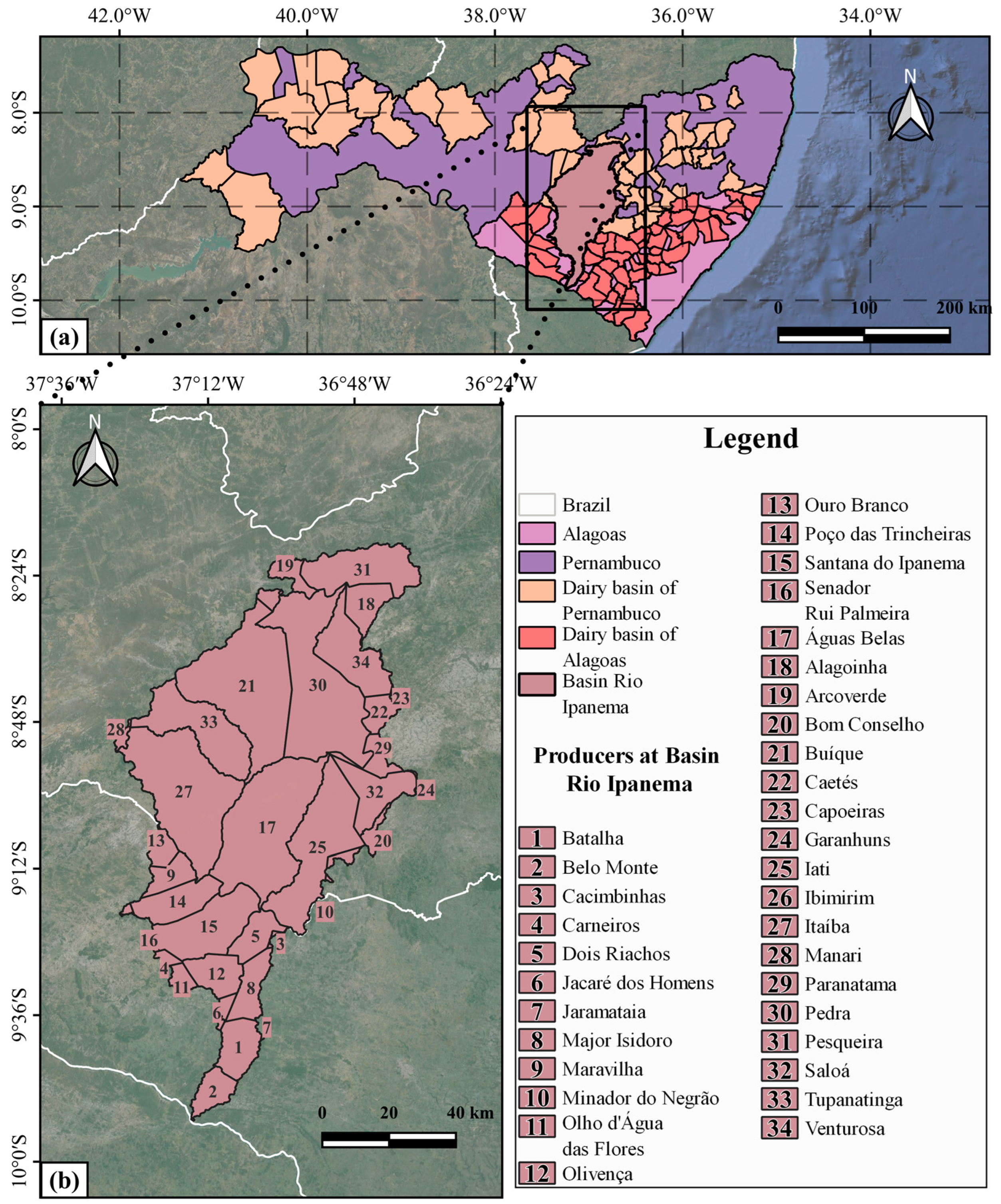

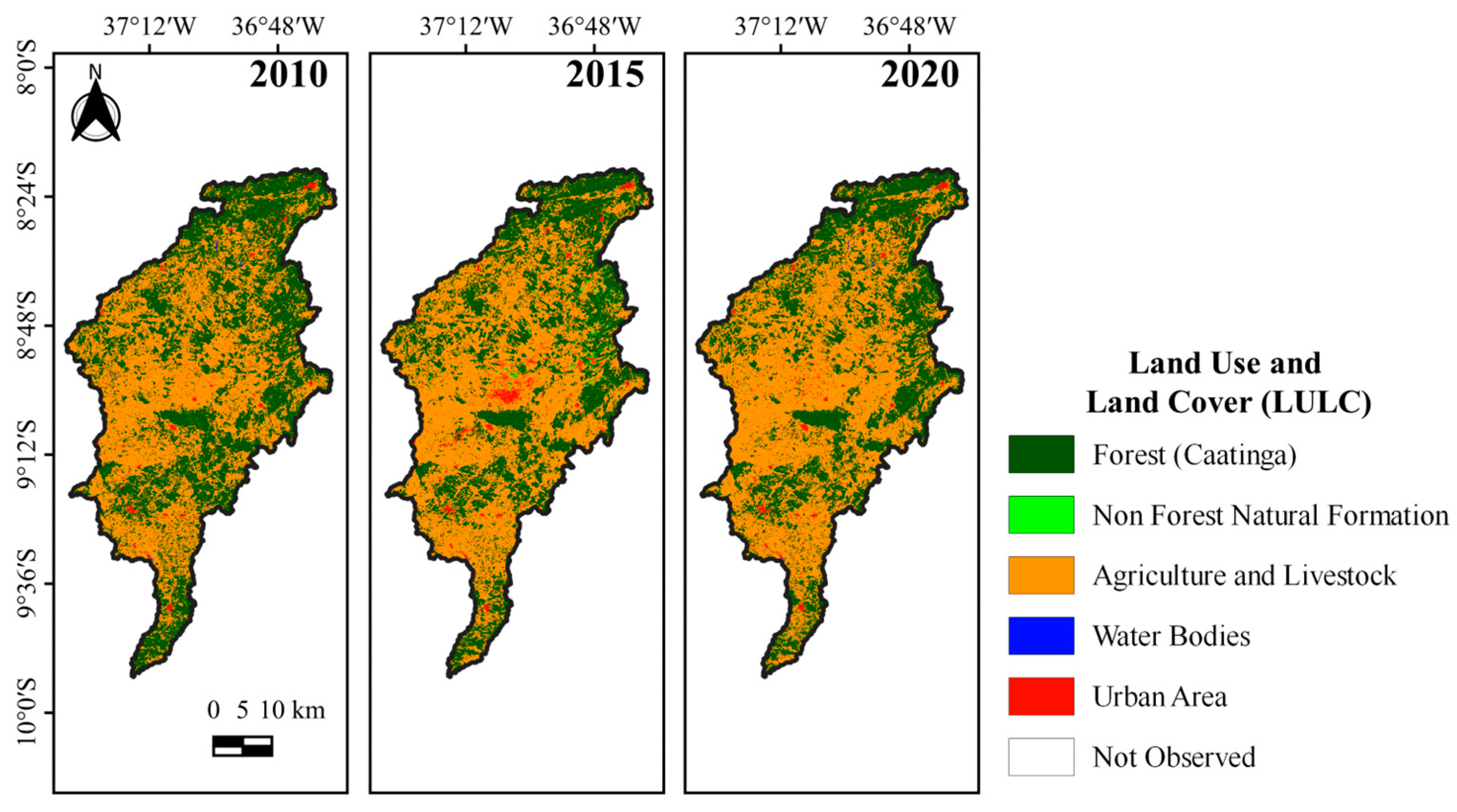

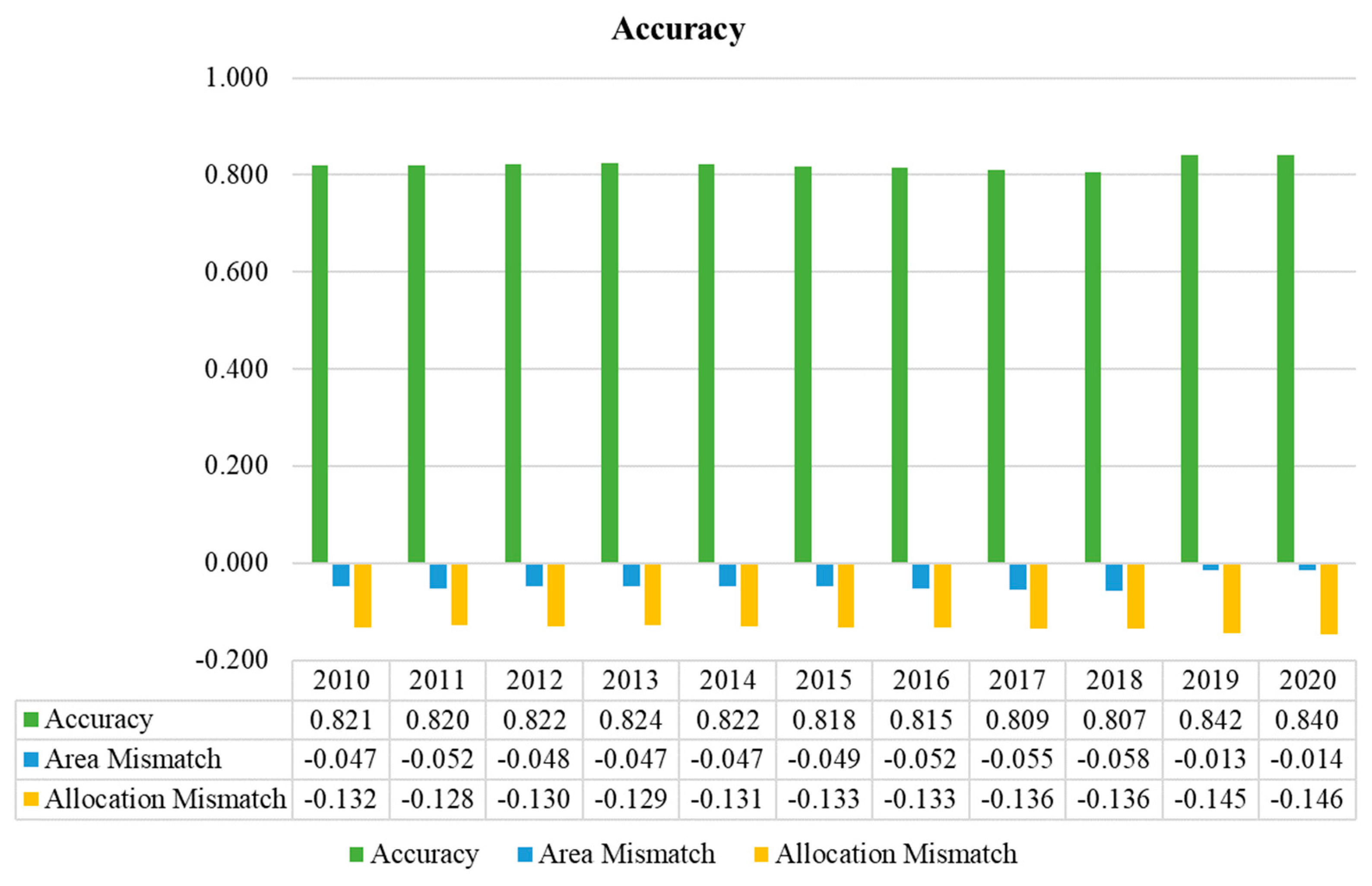
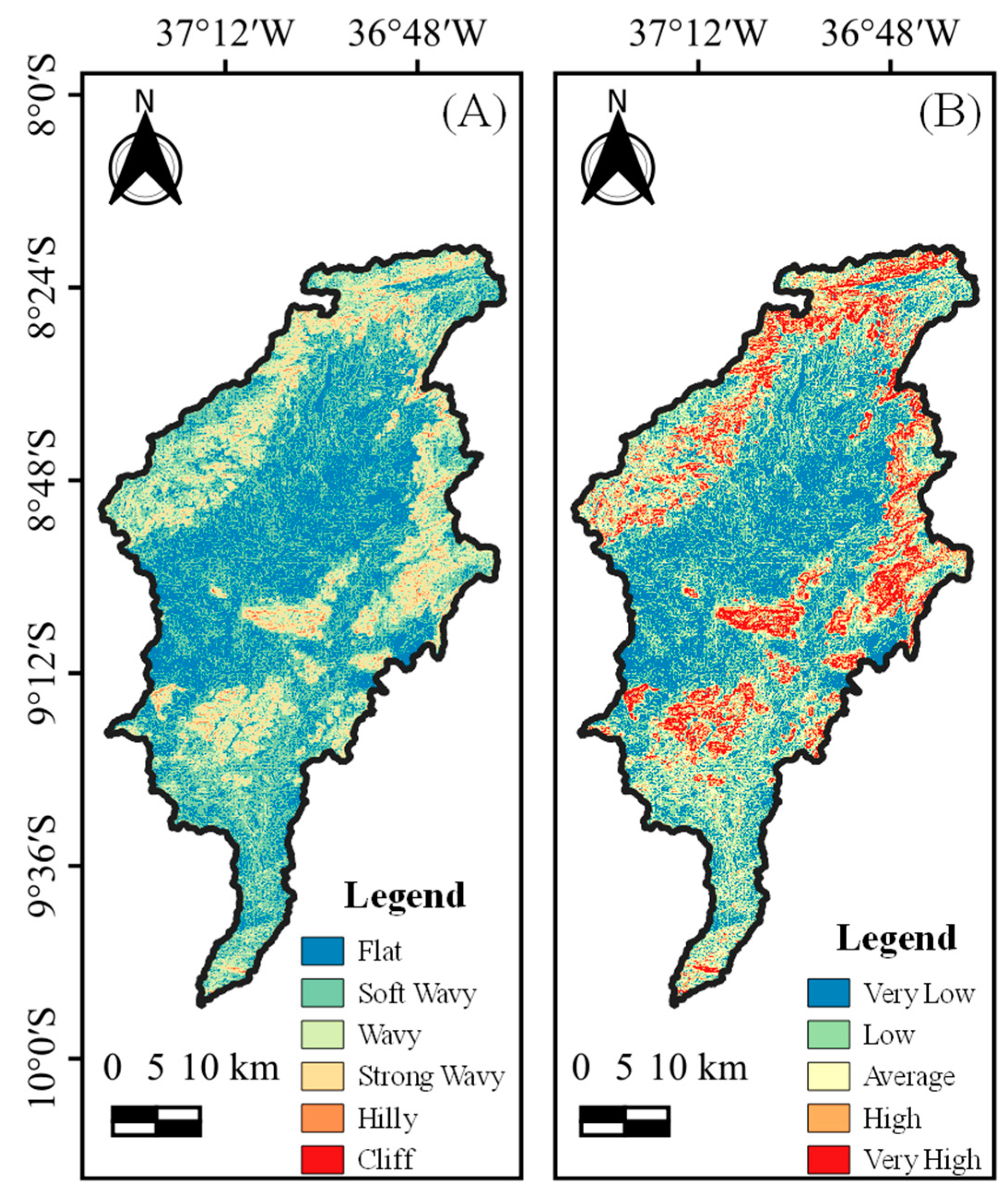
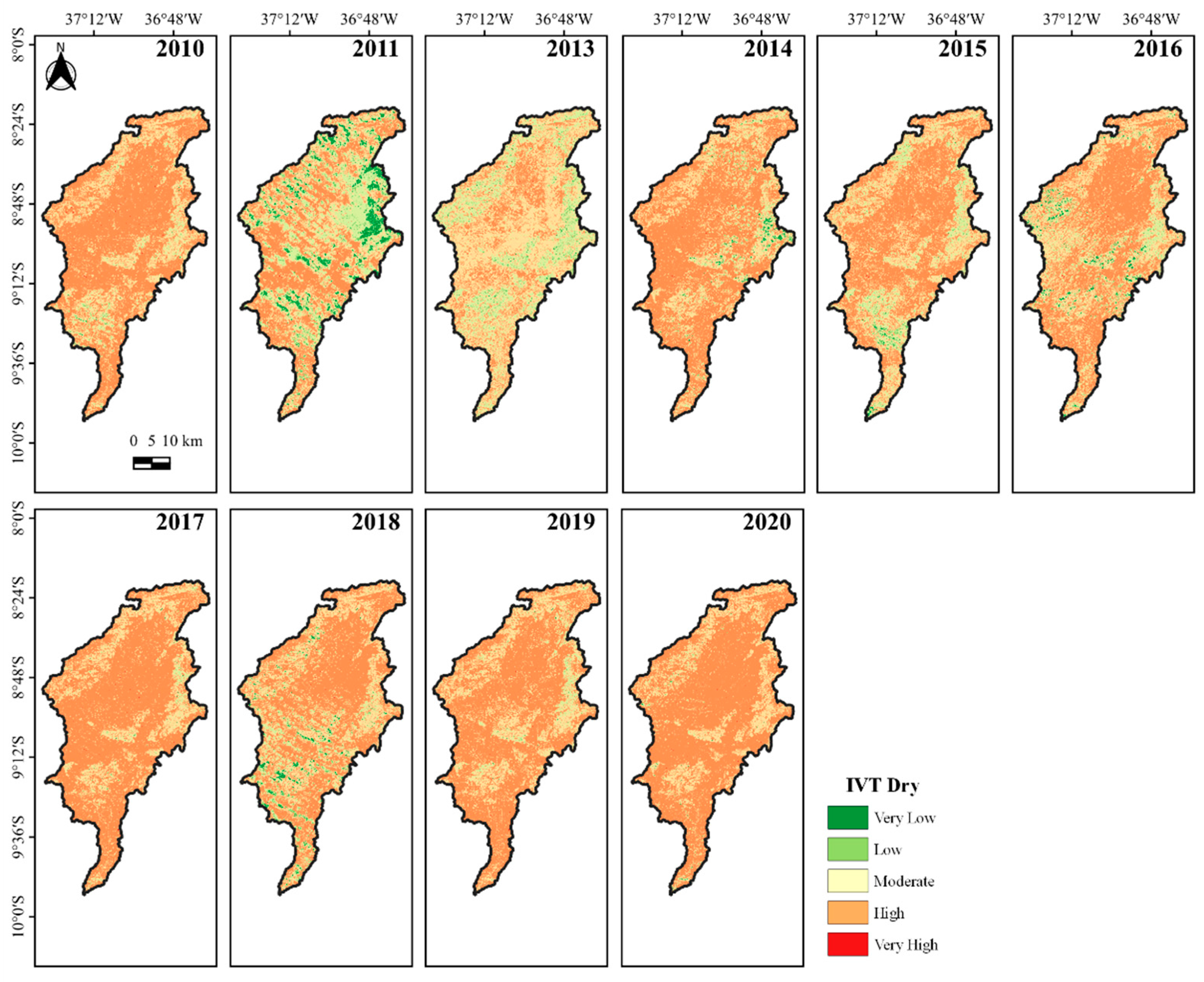
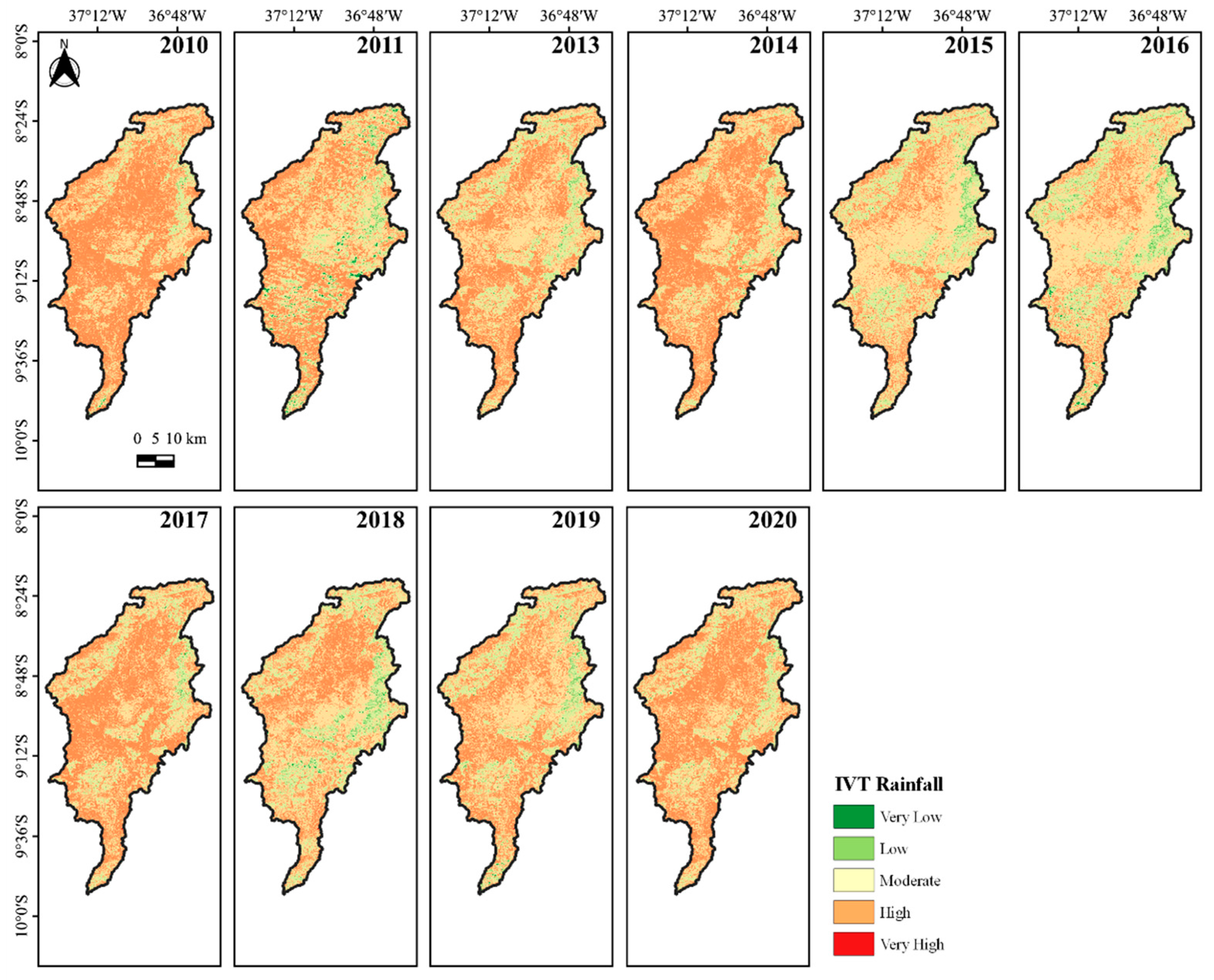


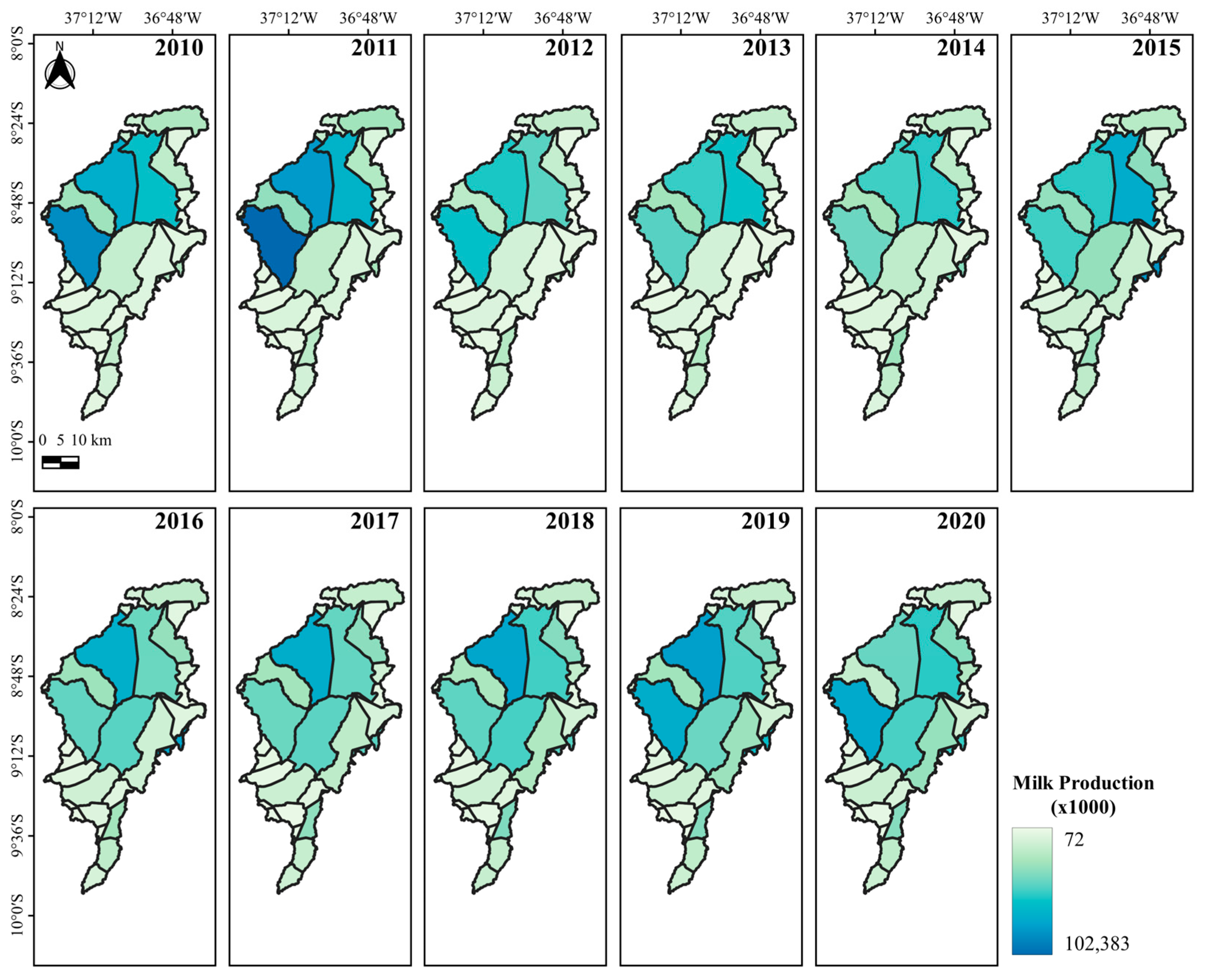
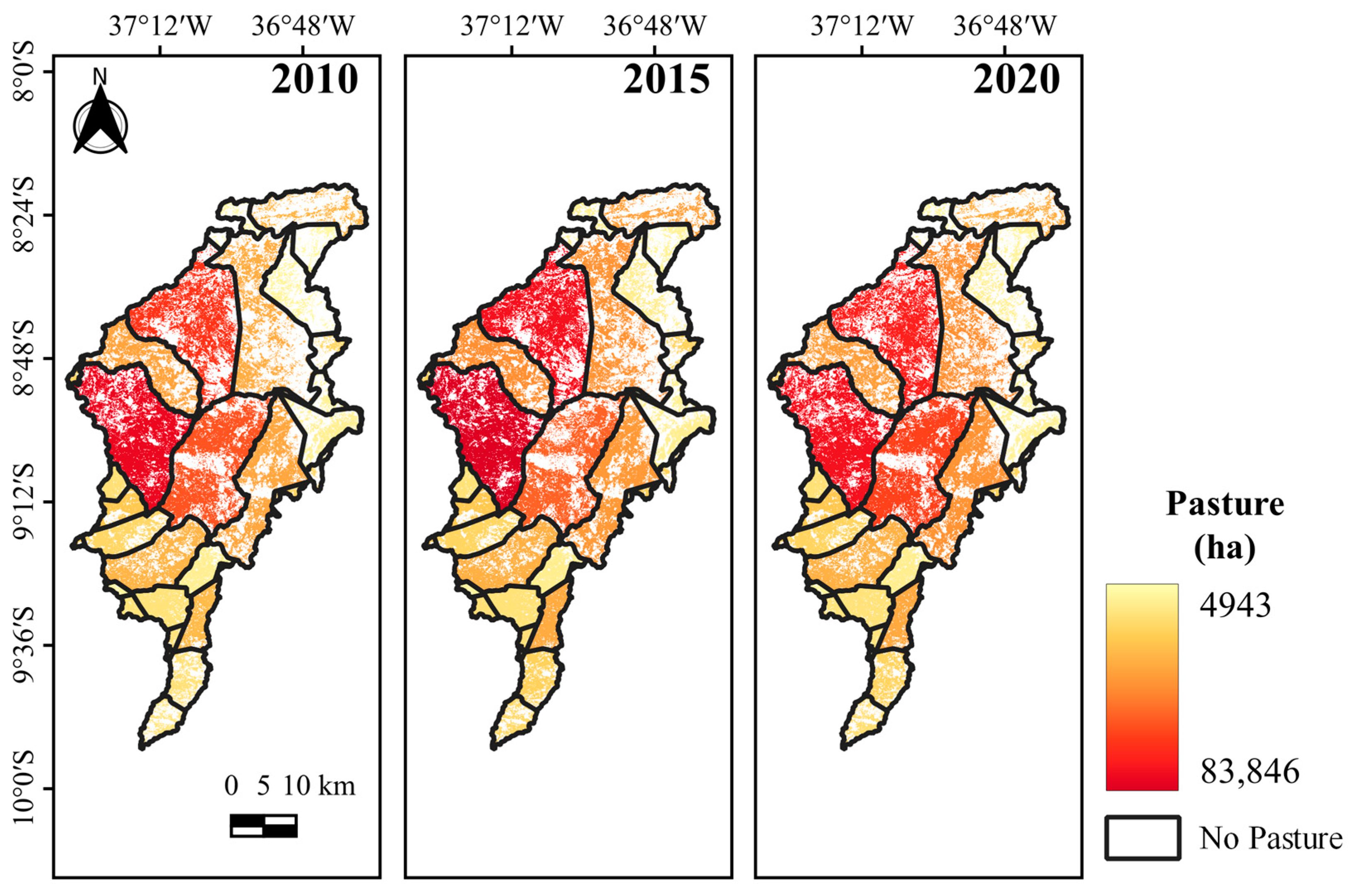

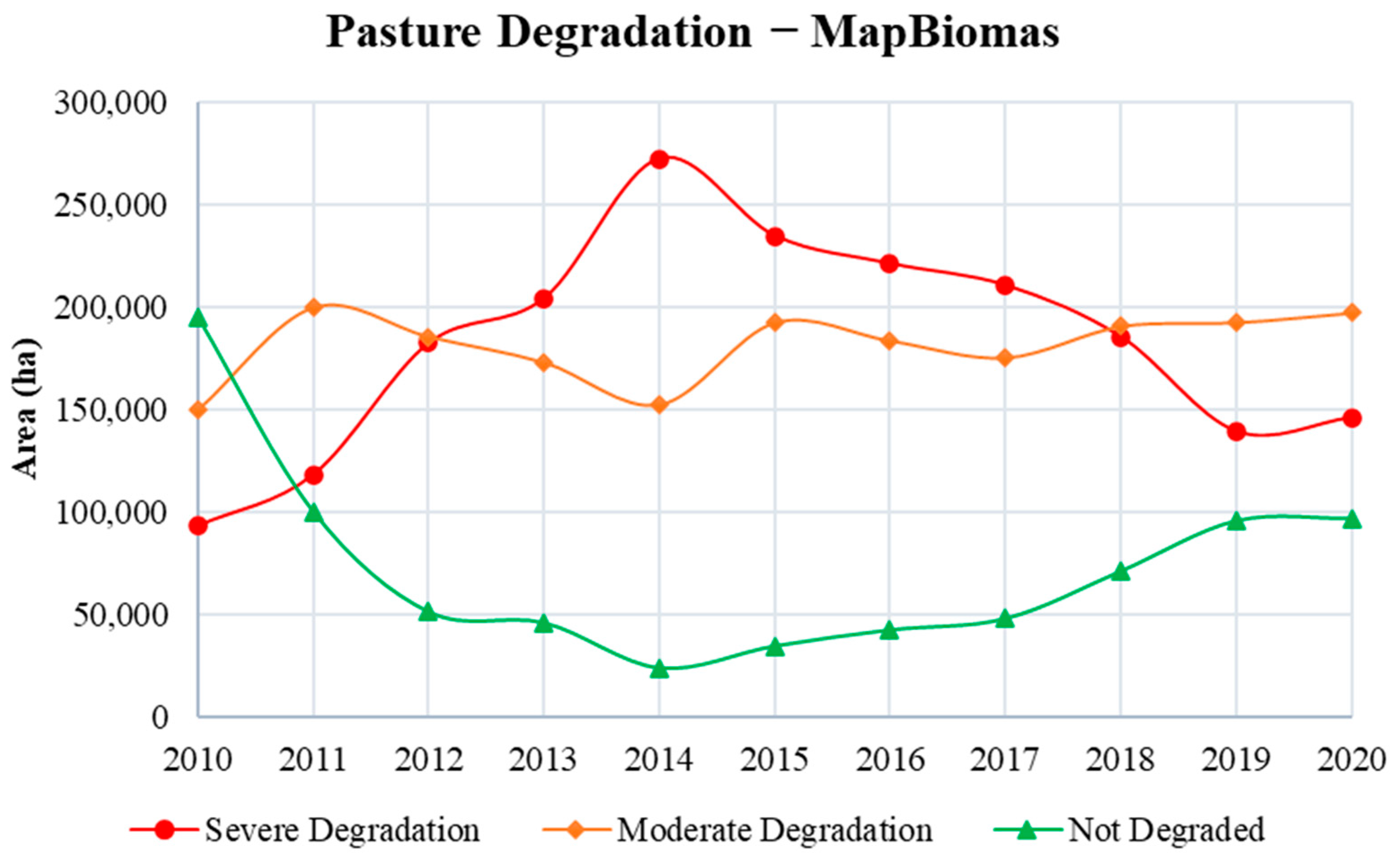
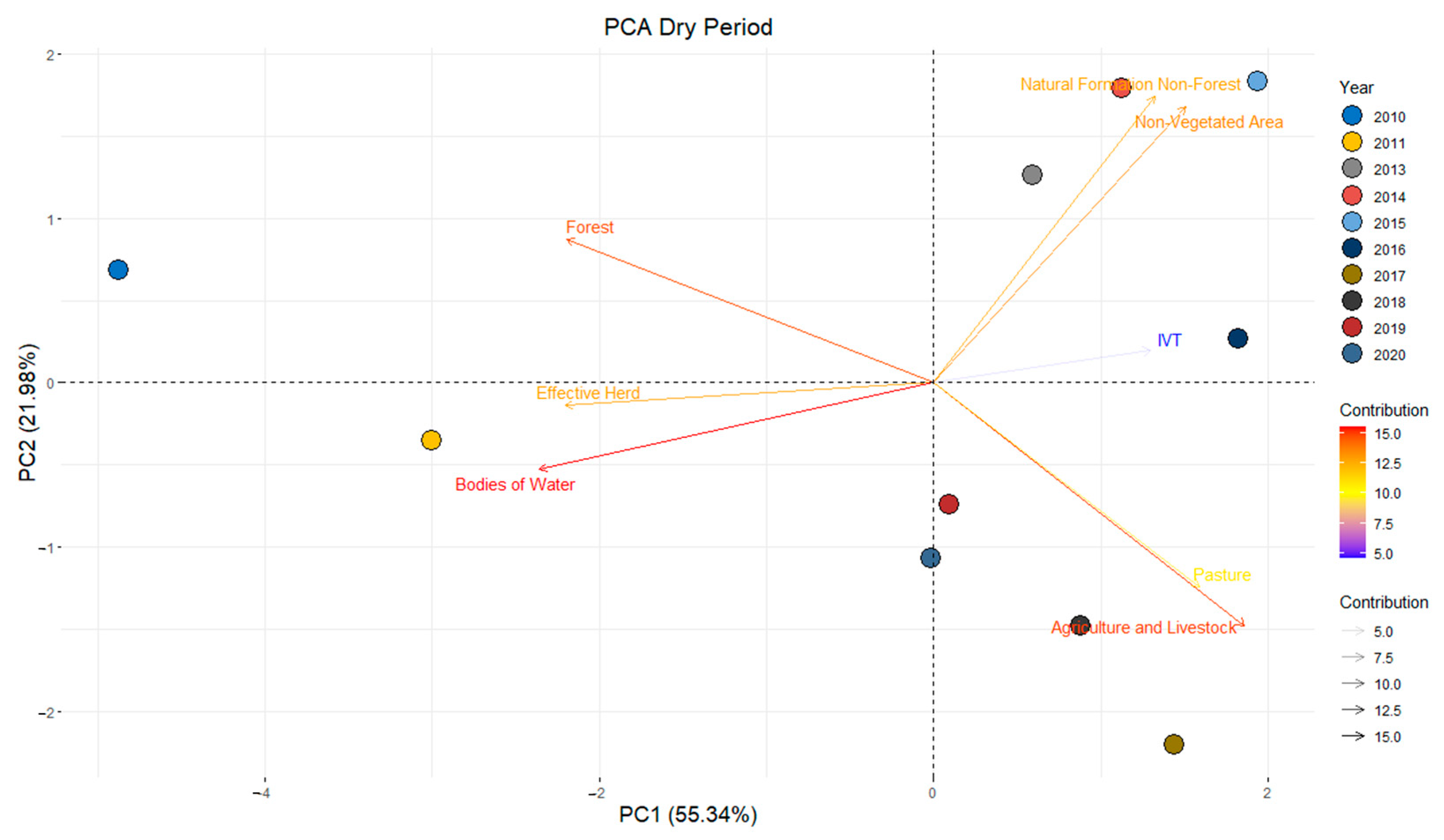

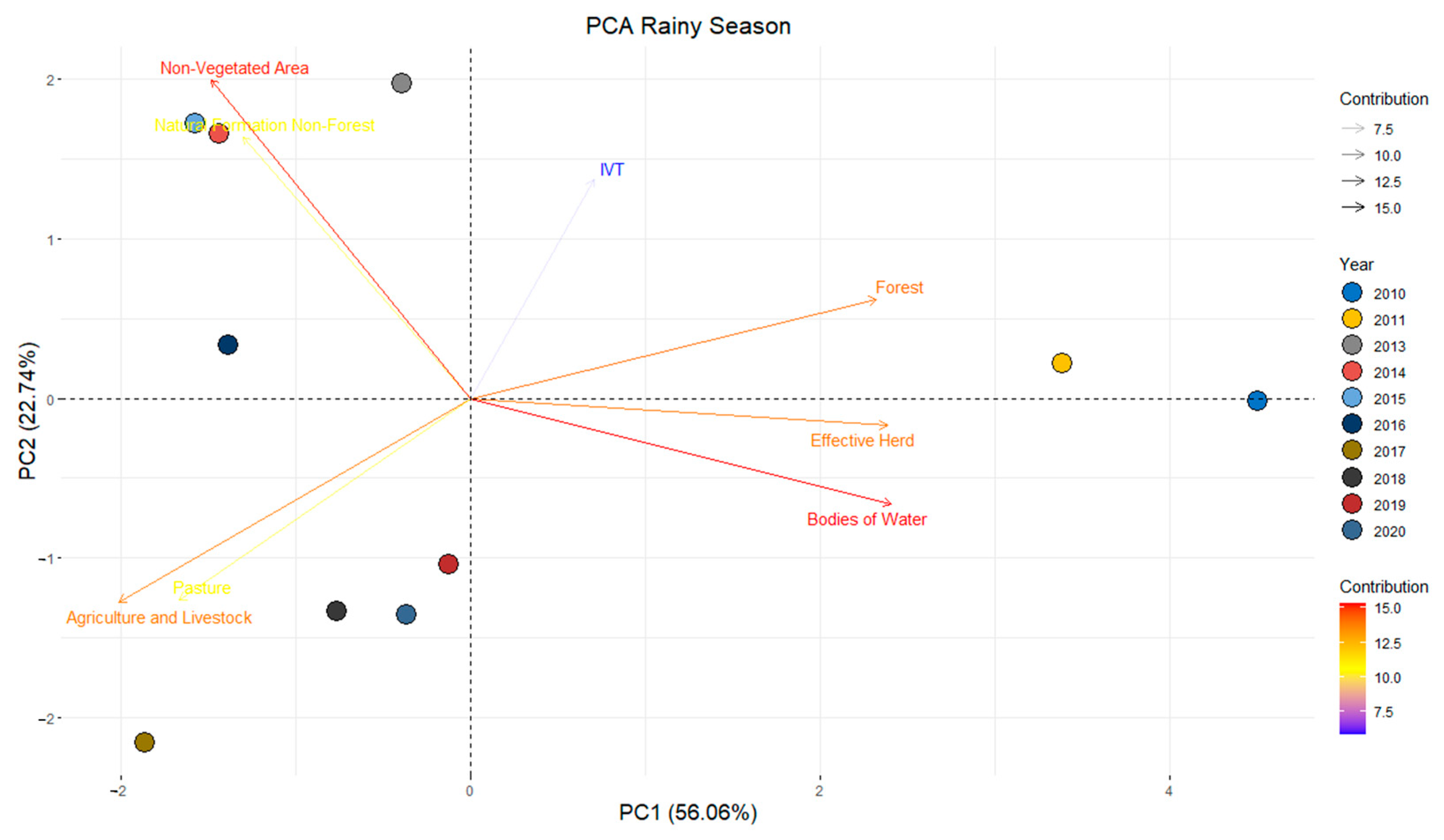

| State | ||
|---|---|---|
| Alagoas | Pernambuco | |
| Total (2017) | ||
| Bovines (unit) | 786,018 | 1,284,796 |
| Cows Milked (unit) | 81,599 | 222,344 |
| Milk Produced (×1000) | 188,628 | 520,990 |
| Basin Rio Ipanema | ||
| Bovines (unit) | 138,325 | 288,580 |
| Cows Milked (unit) | 34,129 | 90,785 |
| Milk Produced (×1000) | 96,778 | 292,533 |
| % Illustrative (Basin/Total) | ||
| Bovines (unit) | 17.6 | 22.5 |
| Cows Milked (unit) | 41.8 | 40.8 |
| Milk Produced (×1000) | 51.3 | 56.1 |
| Band | Spectral Resolution (µm) | Spatial Resolution (m) | Temporal Resolution | |
|---|---|---|---|---|
| TM sensor | r1: Blue | 0.45–0.52 | 30 | 16 days |
| r2: Green | 0.52–0.60 | 30 | ||
| r3: Red | 0.63–0.69 | 30 | ||
| r4: Near Infrared | 0.76–0.90 | 30 | ||
| r5: Near Infrared | 1.55–1.75 | 30 | ||
| r6: Thermal | 10.40–12.50 | 120 | ||
| r7: Mid Infrared | 2.08–2.35 | 30 | ||
| OLI sensor | r1: Costal Aerosol | 0.43–0.45 | 30 | 16 days |
| r2: Blue | 0.45–0.51 | 30 | ||
| r3: Green | 0.53–0.59 | 30 | ||
| r4: Red | 0.64–0.67 | 30 | ||
| r5: Near Infrared | 0.85–0.88 | 30 | ||
| r6: SWIR 1 | 1.57–1.65 | 30 | ||
| r7: SWIR 2 | 2.11–2.29 | 30 | ||
| r8: Panchromatic | 0.50–0.68 | 15 | ||
| r9: Cirrus | 1.36–1.38 | 30 | ||
| r10: Thermal Infrared 1 | 10.6–11.19 | 100 | ||
| r11: Thermal Infrared 2 | 11.50–12.51 | 100 |
| Degradation Risk Class | Class Limits |
|---|---|
| Very Low | 0 to 3 |
| Low | 3 to 6 |
| Average | 6 to 12 |
| High | 12 to 20 |
| Very High | >20 |
| Slope Class | Class Limits (%) |
|---|---|
| Flat | 0–3 |
| Soft Wavy | 3–8 |
| Wavy | 8–20 |
| Strong Wavy | 20–45 |
| Hilly | 45–75 |
| Cliff | >75 |
| Vegetation Classes | Vegetation | Slope | Vulnerability | ||
|---|---|---|---|---|---|
| IBVL * | IVV | IVD | LVI | Class | |
| Very Dense Tree | 1.00 | 1.00 | 0 a 3 | 0 a 6 | Very Low |
| Dense Tree | 0.80 | 1.25 | |||
| Dense Undergrowth | 0.68 | 1.47 | 3 a 6 | 6 a 12 | Low |
| Dense Shrubby Undergrowth | 0.60 | 1.67 | |||
| Dense Sub-Tree Shrub | 0.48 | 2.08 | 6 a 12 | 12 a 24 | Moderate |
| Open Sub-Tree Shrub | 0.36 | 2.78 | |||
| Open Sub-Shrub Shrub | 0.24 | 4.17 | 12 a 20 | 24 a 40 | High |
| Thin Shrubby Sub-Shrub | 0.14 | 7.14 | |||
| Very Sparse Shrubby Shrub | 0.07 | 14.29 | >20 | >40 | Very High |
| Exposed Soil | 0.05 | 20.00 | |||
| LVI | Year | Class Area (%) | ||||
|---|---|---|---|---|---|---|
| Very Low | Low | Moderate | High | Very High | ||
| Dry | 2010 | 0.43 | 6.98 | 25.19 | 67.27 | 0.13 |
| 2011 | 5.73 | 26.77 | 24.77 | 37.35 | 5.38 | |
| 2013 | 1.72 | 25.89 | 44.56 | 27.53 | 0.30 | |
| 2014 | 1.12 | 8.51 | 25.14 | 64.56 | 0.67 | |
| 2015 | 1.05 | 15.15 | 29.42 | 54.02 | 0.35 | |
| 2016 | 1.73 | 14.15 | 28.39 | 54.45 | 1.29 | |
| 2017 | 0.26 | 4.35 | 22.36 | 72.95 | 0.09 | |
| 2018 | 1.95 | 11.64 | 26.67 | 58.47 | 1.28 | |
| 2019 | 0.25 | 6.56 | 25.99 | 67.12 | 0.08 | |
| 2020 | 0.32 | 2.43 | 22.01 | 75.12 | 0.12 | |
| Rainy | 2010 | 0.39 | 9.76 | 28.97 | 60.76 | 0.12 |
| 2011 | 2.50 | 18.68 | 35.40 | 42.39 | 1.03 | |
| 2013 | 0.82 | 19.45 | 37.45 | 42.10 | 0.18 | |
| 2014 | 0.54 | 12.80 | 31.52 | 54.99 | 0.15 | |
| 2015 | 1.76 | 23.41 | 47.02 | 27.52 | 0.28 | |
| 2016 | 3.04 | 20.34 | 46.73 | 29.32 | 0.56 | |
| 2017 | 0.59 | 16.57 | 30.53 | 52.16 | 0.15 | |
| 2018 | 1.91 | 24.49 | 38.21 | 35.01 | 0.39 | |
| 2019 | 1.30 | 22.17 | 37.55 | 38.70 | 0.28 | |
| 2020 | 0.53 | 16.73 | 31.36 | 51.23 | 0.15 | |
| Year | Municipality | ||||
|---|---|---|---|---|---|
| 1° | 2° | 3° | 4° | 5° | |
| 2010 | Itaíba | Bom Conselho | Buíque | Pedra | Tupanatinga |
| 2011 | Itaíba | Buíque | Bom Conselho | Águas Belas | Pedra |
| 2012 | Itaíba | Bom Conselho | Buíque | Águas Belas | Pesqueira |
| 2013 | Itaíba | Buíque | Bom Conselho | Pedra | Águas Belas |
| 2014 | Bom Conselho | Itaíba | Buíque | Pedra | Águas Belas |
| 2015 | Bom Conselho | Itaíba | Buíque | Águas Belas | Pedra |
| 2016 | Bom Conselho | Itaíba | Buíque | Águas Belas | Pedra |
| 2017 | Bom Conselho | Itaíba | Buíque | Águas Belas | Pedra |
| 2018 | Itaíba | Bom Conselho | Buíque | Pedra | Águas Belas |
| 2019 | Itaíba | Bom Conselho | Pedra | Buíque | Águas Belas |
| 2020 | Itaíba | Bom Conselho | Águas Belas | Pedra | Major Isidoro |
| Year | Municipality | ||||
|---|---|---|---|---|---|
| 1° | 2° | 3° | 4° | 5° | |
| 2010 | Itaíba | Buíque | Pedra | Bom Conselho | Pesqueira |
| 2011 | Itaíba | Buíque | Pedra | Bom Conselho | Pesqueira |
| 2012 | Buíque | Itaíba | Pedra | Bom Conselho | Pesqueira |
| 2013 | Pedra | Buíque | Itaíba | Bom Conselho | Tupanatinga |
| 2014 | Bom Conselho | Pedra | Buíque | Águas Belas | Itaíba |
| 2015 | Bom Conselho | Buíque | Pedra | Águas Belas | Itaíba |
| 2016 | Bom Conselho | Buíque | Águas Belas | Pedra | Itaíba |
| 2017 | Buíque | Pedra | Bom Conselho | Itaíba | Águas Belas |
| 2018 | Buíque | Pedra | Bom Conselho | Itaíba | Águas Belas |
| 2019 | Itaíba | Buíque | Bom Conselho | Pedra | Águas Belas |
| 2020 | Itaíba | Pedra | Bom Conselho | Águas Belas | Major Isidoro |
| Year | Municipality | ||||
|---|---|---|---|---|---|
| 1° | 2° | 3° | 4° | 5° | |
| 2010 | Itaíba | Buíque | Pedra | Tupanatinga | Pesqueira |
| 2011 | Itaíba | Buíque | Pedra | Tupanatinga | Pesqueira |
| 2012 | Itaíba | Buíque | Pedra | Major Isidoro | Tupanatinga |
| 2013 | Pedra | Buíque | Itaíba | Tupanatinga | Major Isidoro |
| 2014 | Pedra | Buíque | Itaíba | Bom Conselho | Major Isidoro |
| 2015 | Bom Conselho | Pedra | Buíque | Itaíba | Venturosa |
| 2016 | Bom Conselho | Buíque | Águas Belas | Itaíba | Pedra |
| 2017 | Buíque | Bom Conselho | Águas Belas | Pedra | Itaíba |
| 2018 | Buíque | Pedra | Águas Belas | Bom Conselho | Itaíba |
| 2019 | Buíque | Itaíba | Bom Conselho | Pedra | Águas Belas |
| 2020 | Itaíba | Pedra | Bom Conselho | Águas Belas | Buíque |
| Year | Municipality | ||||
|---|---|---|---|---|---|
| 1° | 2° | 3° | 4° | 5° | |
| 2010 | Itaíba | Buíque | Águas Belas | Ibimirim | Tupanatinga |
| 2011 | Itaíba | Buíque | Águas Belas | Ibimirim | Tupanatinga |
| 2012 | Itaíba | Buíque | Águas Belas | Ibimirim | Tupanatinga |
| 2013 | Itaíba | Buíque | Águas Belas | Ibimirim | Tupanatinga |
| 2014 | Itaíba | Buíque | Ibimirim | Águas Belas | Tupanatinga |
| 2015 | Itaíba | Buíque | Ibimirim | Águas Belas | Tupanatinga |
| 2016 | Itaíba | Buíque | Ibimirim | Águas Belas | Tupanatinga |
| 2017 | Itaíba | Buíque | Ibimirim | Águas Belas | Pedra |
| 2018 | Itaíba | Buíque | Ibimirim | Águas Belas | Pedra |
| 2019 | Itaíba | Ibimirim | Buíque | Águas Belas | Pedra |
| 2020 | Itaíba | Ibimirim | Buíque | Águas Belas | Pedra |
| Classes | Area (ha) | ||
|---|---|---|---|
| Severe Degradation | Moderate Degradation | Not Degraded | |
| 2010 | 93,359 | 150,009 | 195,328 |
| 2011 | 118,347 | 199,882 | 100,442 |
| 2012 | 182,393 | 185,604 | 51,579 |
| 2013 | 204,220 | 173,107 | 46,250 |
| 2014 | 272,222 | 152,569 | 24,260 |
| 2015 | 234,501 | 192,537 | 35,032 |
| 2016 | 221,027 | 183,626 | 42,873 |
| 2017 | 210,405 | 175,385 | 48,414 |
| 2018 | 185,251 | 190,702 | 71,657 |
| 2019 | 139,294 | 192,502 | 96,151 |
| 2020 | 146,173 | 197,212 | 97,255 |
| Dry Season | ||||||||
| PC(1) | PC(2) | PC(3) | PC(4) | PC(5) | PC(6) | PC(7) | PC(8) | |
| Eigenvalue | 4.43 | 1.76 | 1.00 | 0.42 | 0.21 | 0.17 | 0.02 | 0.00 |
| Total Variance | 0.55 | 0.22 | 0.12 | 0.05 | 0.03 | 0.02 | 0.00 | 0.00 |
| Cumulative variance (%) | 55.3% | 77.3% | 89.8% | 95.1% | 97.7% | 99.8% | 100.0% | 100.0% |
| Rainy Season | ||||||||
| PC(1) | PC(2) | PC(3) | PC(4) | PC(5) | PC(6) | PC(7) | PC(8) | |
| Eigenvalue | 4.26 | 1.91 | 0.99 | 0.55 | 0.21 | 0.06 | 0.02 | 0.00 |
| Total Variance | 0.53 | 0.24 | 0.12 | 0.07 | 0.03 | 0.01 | 0.00 | 0.00 |
| Cumulative variance (%) | 53.2% | 77.2% | 89.6% | 96.5% | 99.1% | 99.8% | 100.0% | 100.0% |
Disclaimer/Publisher’s Note: The statements, opinions and data contained in all publications are solely those of the individual author(s) and contributor(s) and not of MDPI and/or the editor(s). MDPI and/or the editor(s) disclaim responsibility for any injury to people or property resulting from any ideas, methods, instructions or products referred to in the content. |
© 2024 by the authors. Licensee MDPI, Basel, Switzerland. This article is an open access article distributed under the terms and conditions of the Creative Commons Attribution (CC BY) license (https://creativecommons.org/licenses/by/4.0/).
Share and Cite
Silva, J.B.A.d.; de Almeida, G.L.P.; da Silva, M.V.; de Oliveira-Júnior, J.F.; Pandorfi, H.; Giongo, P.R.; de Almeida Macêdo, G.A.P.; Guiselini, C.; Marinho, G.T.B.; Bakke, I.A.; et al. Spatio-Temporal Modeling of Land and Pasture Vulnerability in Dairy Basins in Northeastern Brazil. AgriEngineering 2024, 6, 2970-3000. https://doi.org/10.3390/agriengineering6030171
Silva JBAd, de Almeida GLP, da Silva MV, de Oliveira-Júnior JF, Pandorfi H, Giongo PR, de Almeida Macêdo GAP, Guiselini C, Marinho GTB, Bakke IA, et al. Spatio-Temporal Modeling of Land and Pasture Vulnerability in Dairy Basins in Northeastern Brazil. AgriEngineering. 2024; 6(3):2970-3000. https://doi.org/10.3390/agriengineering6030171
Chicago/Turabian StyleSilva, Jéssica Bruna Alves da, Gledson Luiz Pontes de Almeida, Marcos Vinícius da Silva, José Francisco de Oliveira-Júnior, Héliton Pandorfi, Pedro Rogerio Giongo, Gleidiana Amélia Pontes de Almeida Macêdo, Cristiane Guiselini, Gabriel Thales Barboza Marinho, Ivonete Alves Bakke, and et al. 2024. "Spatio-Temporal Modeling of Land and Pasture Vulnerability in Dairy Basins in Northeastern Brazil" AgriEngineering 6, no. 3: 2970-3000. https://doi.org/10.3390/agriengineering6030171







